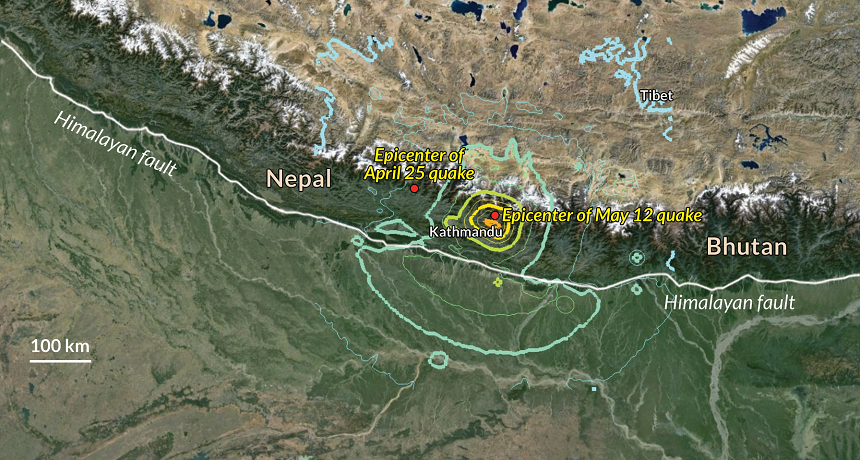Major new quake rattles Nepal
It’s a third as strong as the one that hit 17 days earlier

A massive May 12 aftershock hit earthquake-ravaged eastern Nepal. Colored lines indicate the intensity of ground shaking caused by the quake, which was even felt in northern India and Bangladesh.
GOOGLE EARTH PRO, OVERLAY BY USGS, ADAPTED BY M. TELFER
By Janet Raloff
A magnitude 7.3 earthquake rattled eastern Nepal on May 12. It’s the largest quake to hit since a massive 7.8 magnitude quake devastated the region 17 days earlier. That earlier quake killed more than 8,000 people.
The new earthquake occurred roughly 80 kilometers to the east-northeast of the Nepal’s capital city, Kathmandu. It took place where the India tectonic plate is converging with the Eurasian plate at a rate of 45 millimeters (almost 1.8 inches) per year. Part of the collision is helping to raise the Himalayan mountain range a bit each year.
Energy from the earlier, April 25 quake was directed from its center eastwards and towards Kathmandu along a fault, which is a natural rupture in Earth’s crust. The magnitude 7.3 aftershock occurred just beyond the eastern end of that rupture, the U.S. Geological Survey reports.
The new quake’s epicenter was near Mount Everest. That’s some 150 kilometers (93 miles) east of where the April 25 quake had been centered. The enormous, new aftershock released roughly one third as much pent-up energy as had powered the main earthquake.
Tremendous earth-shaking energy was released during this and the April 25 tremors. Still, researchers say, the affected region remains primed for even more powerful quakes.
And the magnitude 7.3 quake wasn’t the only large aftershock on May 12. Thirty-one minutes after that first big quake hit, a still substantial magnitude 6.3 aftershock rattled the region.
Power Words
(for more about Power Words, click here)
aftershock One or more smaller earthquakes which often follow a major earthquake.
crust (in geology) Earth’s outermost surface, usually made from dense, solid rock.
earthquake A sudden and sometimes violent shaking of the ground, sometimes causing great destruction, as a result of movements within Earth’s crust or of volcanic action.
fault In geology, a fracture along which there is movement of part of Earth’s rocky, outermost shell, or lithosphere.
Himalayas A mountain system in Asia that divides the Tibetan Plateau to its north from the plains of Indian to the south. Containing some of the highest mountains in the world, the Himalayas include more than 100 that rise at least 7,300 meters (24,000 feet) above sea level. The tallest is known as Mount Everest.
magnitude (for earthquakes) A measurement of the intensity of the ground-shaking associated with an earthquake. The scale is logarithmic. So for every 1 point increase in magnitude (such as from 3 to 4), there is a 10 fold increase in ground motion (how far the land shakes back and forth) and a roughly 33-fold increase in the amount of energy released.
epicenter The underground location along a fault where an earthquake starts.
tectonic plates The gigantic slabs — some spanning thousands of kilometers (or miles) across — that make up Earth’s outer layer.
U.S. Geological Survey, or USGS This is the largest nonmilitary U.S. agency charged with mapping water, Earth and biological resources. It collects information to help monitor the health of ecosystems, natural resources and natural hazards. It also studies the impacts of climate and land-use changes. A part of the U.S. Department of the Interior, USGS is headquartered in Reston, Va.







